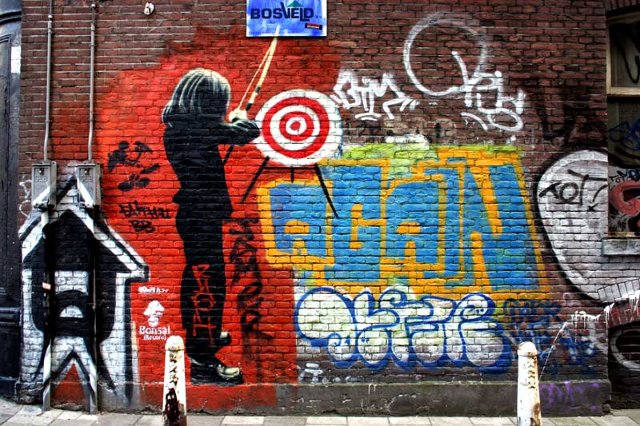 |
| Image: Flickr user Aldo Cauchi Savona |
Graffiti isn't always a sign of criminal disorder; it can actually be a boon to cities' economies.
Graffiti-hunting has become a sort of tourism. People visit East London or New York’s Lower East Side and Williamsburg or, formerly, 5Pointz, just to see some of the graffiti there.
“Some scholars have questioned whether we should consider graffiti criminal damage if in fact, it’s a Banksy piece that’s worth $100,000 - if you can somehow get it off the wall,” Douglas says.
Economist Elizabeth Currid-Halkett, an associate professor at the University of Southern California, says there’s a strong relationship between the cultural activity of a city - which graffiti is a part of - and its economy.
“When you see graffiti, it’s really a sign of many more interesting creative things going on,” she told Co.Design. Cities that have more graffiti tend to be cultural and artistic hubs.
And street art tends to give people who don’t have the resources to launch a more traditional art career a shot. “Historically, graffiti artists were kids from poor neighborhoods, working class families, who didn’t have resources, and the city became their canvas,” Currid-Halkett explains.
“I think that that’s an important part of the ecology of a city … it allows people who don’t have much to make it.
Street art has a positive effect on how unique a cityscape looks.
With the exception of “legal walls,” where street artists are allowed to tag, spray painting someone else’s property is still a crime, though, and Douglas warns that not all graffiti is a force for good. “In many cases,” he says, graffiti “is still associated with gang activity.”
Preliminary data from Place Pulse, an MIT project that functions as kind of a “hot or not” for cities, allowing people to compare pictures of urban neighborhoods and rate whether they seem safe, wealthy, lively, etc., suggests that people don’t see all graffiti as equal.
“We did some preliminary studies in this topic, and have suggestive, but not conclusive evidence that street art has a positive effect on how unique a cityscape looks,” Cesar Hidalgo, a professor at the MIT Media Lab, wrote me in an email.
However, “graffiti tags are associated with a decline in the perception of safety and class of a place,” he notes.
The Australian city of Melbourne, which boasts of its "internationally renowned" street art, used similar research findings when deciding to allow larger street art, but not tags.
A city website notes that "most people do not like graffiti ‘tagging’ (person writing their graffiti name or ‘tag’ on a wall with marker or paint). However, many people appreciate ‘street art’ such as larger, more artistic pieces, or murals placed in appropriate locations with the required permission."
Despite the differences in how people perceive a mural on a wall versus a a name tagged on a mailbox, the two are essentially inseparable, Currid-Halkett says. “You don’t have one without the other,” she says. “They’re both big components of graffiti subculture.”
And that unique look that street art provides a neighborhood really sells. As Douglas puts it, “if a piece is really beautiful and wheat-pasted, that doesn’t mean the property owner wants it on their wall, but it probably isn’t a provocation of greater disorder or a gang sign. It’s more likely an indication that young, hip, middle-class people are going to want to drink beer nearby.”
No comments:
Post a Comment